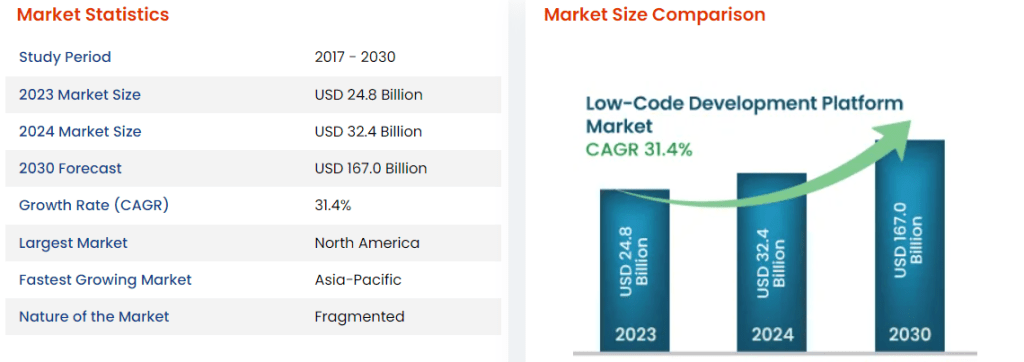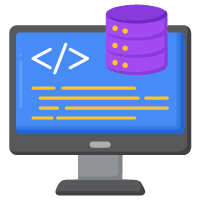Key Highlights
- Low-code platforms are changing the way businesses make software. They speed up development and support citizen developers.
- This blog post talks about the top 5 platforms for 2024. It examines their unique features and their pros and cons.
- OutSystems, Mendix, Microsoft Power Apps, Appian, and Salesforce Lightning are changing how companies handle software development.
- These platforms have different tools. They offer quick prototypes and strong solutions for big businesses, meeting different needs.
- By knowing the strengths of each platform, companies can make smart choices. This helps speed up their digital transformation process.
Introduction
In today’s rapidly evolving tech landscape, staying ahead requires agility and innovation. Low-code platforms have emerged as game-changers in enterprise development, enabling businesses to swiftly adapt and innovate.
Digital transformation is key for businesses to remain competitive. Application development helps companies work better. Low-code platforms are very useful. They let more people build apps quickly and easily, with minimal coding required. This speeds up getting software solutions to customers. By using low-code, businesses can be more flexible and enhance their application development. A mix of professional developers and citizen developers can help make this happen.
Exploring the Top 5 Low Code Platforms for Enterprise Development in 2024
In 2024, more businesses are using low code platforms. Companies see that quick development helps them launch products faster. This has made low code very popular for many software needs. Low code platforms can assist with many tasks. They can improve teamwork, create apps for customers, and link different systems to raise efficiency.
Many businesses want new and better ways to create software. Because of this need, several providers of low code platforms have joined the market. Picking the right platform is very important. It should match your business needs. Think about how well it can grow, how it works with other services, its security features, and how easy it is to use. Now, let’s look at the top 5 low code platforms that will lead development in 2024.
1. OutSystems

OutSystems is a top low-code platform. It helps businesses build complex enterprise applications fast. The platform uses a simple visual development system. This makes it easy for developers of all skills. OutSystems helps close the skills gap and speeds up software development.
It helps teams work together by providing tools for version control and feedback. This keeps everyone on the same page, especially between business and IT teams. Moreover, OutSystems places a high value on security and compliance. This makes it a safe option for companies that must follow strict rules.
Features That Set OutSystems Apart
OutSystems is unique because it has features that help users and make development simpler. Its user-friendly design and lots of development tools allow users to create powerful apps fast and easily.
Some key features of OutSystems are:
- Simple Visual Editor: The drag-and-drop interface helps you create user interfaces easily. This makes it simple to build attractive and responsive applications.
- Pre-Made Templates and Parts: There are many ready-made templates and components available. This speeds up development and means you don’t have to start from scratch.
- Seamless Integration: OutSystems connects well with current systems and data sources. This keeps data consistent and helps businesses use their existing technology effectively.
These features, combined with OutSystems’ excellent customer support and a helpful community forum, make it one of the best choices for companies looking for an easy and complete low code development platform.
Pros and Cons of Choosing OutSystems
OutSystems gives a powerful solution for companies that want to speed up their digital changes. They do this by using low code development.
These benefits include:
- Faster App Development: OutSystems helps professional developers and business users create apps quickly. This reduces the time needed to launch them.
- Better Operational Efficiency: OutSystems improves operations and makes them more efficient. It does this by automating tasks and connecting with existing systems.
- Great Mobile App Development: OutSystems shines in mobile app development. It helps businesses create apps that work well on both iOS and Android devices.
There are some things to consider about OutSystems.
- Cost Concern: Small businesses or those with limited budgets may feel that the costs of OutSystems are too high.
- Possible Vendor Lock-in: Companies need to be careful not to get stuck with just one platform if they decide to use it.
How OutSystems Serves Different Industries
Large enterprises in areas like finance, healthcare, and telecommunications can gain a lot from OutSystems. It is really good for scaling up and has strong integration features.
2. Mendix

Mendix is known for being easy to use. It helps create advanced apps for different businesses. With low code app development, users can build apps quickly. The visual modeling and reusable parts make it easier for developers and business users to work together.
Mendix makes it easy to create complicated business logic. It has a visual microflow editor that helps automate tasks and improve workflows. Since it is cloud-based, it offers flexibility and scalability. This means that applications can grow and change with businesses. Plus, ready-to-use connectors help with adding data sources easily.
Unique Features of Mendix
Mendix stands out from other low-code platforms. It gives tools that simplify the development process. You also get great customization options. This allows people to build strong business apps.
Here are some key features of Mendix:
- AI-Assisted Development: Mendix helps developers by using AI. It gives suggestions for improvement, takes care of routine tasks, and helps find and correct errors.
- Reusable Components and Modules: Mendix encourages users to create components and modules that are easy to use again. You can share these with others and use them in different projects.
- Offline Mobile Functionality: Mendix lets users build mobile apps that work without the internet. This feature is great for field workers or companies in areas with poor internet connection.
These special features, plus support from a lively community and a focus on new ideas, make Mendix a popular choice for businesses. They want a strong and flexible code platform.
Mendix: Advantages and Limitations
Mendix offers several benefits for organizations that want to use low code for app development. It has a simple interface and many powerful features. This makes it an excellent choice for businesses of any size.
Here are some important benefits of Mendix:
- Comprehensive Free Plan: Mendix offers a free plan. This lets organizations try the platform and build simple apps at no cost.
- Seamless Integration with Diverse Data Sources: Mendix connects easily with many data sources, cloud services, and business systems. This helps companies a lot.
- Focus on Collaboration and User Experience: Mendix works to enhance teamwork and user experience. It provides tools for feedback, managing versions, and testing with users during the development process.
There are a few limits to keep in mind.
- Learning Curve for Complex Apps: Mendix is good for making simple or moderately complex apps. However, creating very customized or feature-rich applications can be difficult. Learning this may require additional time.
- Potential Performance Bottlenecks: Like any platform, if you grow apps to handle large data or many users, you might need to change the design. This will help keep the performance steady.
Industries That Benefit Most from Mendix
Manufacturing, logistics, and retail companies can use Mendix to make their operations better. This platform helps them work together and boosts efficiency in their processes.
3. Microsoft Power Apps

Microsoft Power Apps works well with other Microsoft tools like Power Automate and Power BI. It helps businesses create workflows, automate tasks, and understand data. The design is easy to use, allowing citizen developers to build custom apps without needing IT help. Organizations can make their digital transformation easier, boost productivity, and encourage teamwork by sharing data easily in the familiar Microsoft setting.
Key Features of Microsoft Power Apps
Microsoft Power Apps aim to make app development fast and simple. It is easy to use and includes several tools and features. These tools allow users to build custom applications without any hassle.
Below are some essential features of Power Apps:
- Drag-and-Drop Functionality: Power Apps provides a simple visual tool. Users can create their app screens by dragging and dropping items on the canvas.
- Rich Templates and Components: There is a big library of templates and components. This allows users to quickly set up and change different parts of the app.
- AI-Powered Assistance: Microsoft adds AI features to Power Apps. Tools like AI Builder and Copilot help users collect data, find items, and automate tasks.
Power Apps is a great choice. It connects quickly to data sources such as SharePoint, Excel, and Common Data Service. This means businesses can create applications using low code with little effort.
Pros and Cons of Microsoft Power Apps
Microsoft Power Apps has many advantages for organizations. It helps citizen developers create apps easily. It also speeds up app development.
Here are some key benefits of Power Apps:
- Easier for Citizen Developers: The drag-and-drop interface in Power Apps allows people with little coding knowledge to participate in app development easily.
- Easy Integration with Microsoft 365: Companies using Microsoft 365 tools, like SharePoint and Teams, can access their data and user settings quickly. This helps them develop and launch apps more easily.
- Cost-Friendly for Microsoft Users: The cost of Power Apps is often included in current Microsoft 365 subscriptions. This makes it a wise option for businesses already using Microsoft products.
Still, there are some limitations to keep in mind:
- Limited Customization for Complex Apps: Power Apps is great for standard business applications. But, it may struggle with custom rules for complex or special apps.
- Dependence on Microsoft: Businesses using non-Microsoft tools might run into problems. Power Apps works best with Microsoft products.
Use Cases and Industry Applications
Organizations in education, government, and professional services can gain a lot from Power Apps. This tool works well with other Microsoft products. It is also cost-effective.
4. Appian

Appian is a leading low-code platform aimed at automating processes to improve business operations. Its easy drag-and-drop interface helps users complete tasks faster. Both professional and citizen developers can build applications that automate tasks and workflows quickly and easily. It works well with other systems, making it simple to connect everything. This boosts collaboration and case management, making the workplace more effective.
Distinctive Features of Appian
Appian is different from other low-code platforms. It has special features that solve specific business problems. These features also make the user experience better. Plus, they provide great customization options.
Key features of Appian include:
- Smart Process Automation: Appian uses AI and robotic process automation, known as RPA, to make hard tasks easier. It analyzes data and helps you make smart decisions.
- One Data Source: The Appian Data Fabric helps you link and handle data from various places. This makes one main source of information and fills in any missing data.
- Better Security and Compliance: Appian puts effort into keeping your data secure and following rules. It provides tools to guard important information and make sure you meet compliance standards.
Appian helps companies make custom solutions. These solutions match what they need and help make work simpler. They also support digital transformation.
Evaluating the Pros and Cons of Appian
Appian offers several benefits for businesses. It simplifies operations and automates tasks. This shows companies how to create strong business applications.
Here are some of Appian’s main strengths:
- Strong Process Automation Abilities: Appian is great at process automation. This helps businesses work faster, make fewer errors, and enhance workflows.
- Faster Development with Visual Tools: Appian has a simple drag-and-drop interface. It also features a visual development area, making it easy to create apps and quicken delivery.
- Emphasis on Teamwork and Case Management: Appian’s teamwork and case management tools improve communication and collaboration. This raises operational efficiency.
Appian has several benefits. However, there are some things to consider.
- Complicated Pricing: Appian’s pricing can be hard to follow. The costs may rise based on use and chosen features. This can be challenging for small businesses or those with limited budgets.
- Learning Curve: Though Appian is designed to be user-friendly, it might take time to grasp its advanced features. This is especially true for tasks like orchestration and integration.
Appian’s Impact Across Various Sectors
Financial services, insurance, and healthcare groups can use Appian. They can help automate tricky tasks and make their operations more efficient.
5. Salesforce Lightning

Salesforce Lightning is a low code platform. It improves CRM systems and custom business apps without needing coding skills. This platform is flexible and simple to use. Users can customize their Salesforce experience. They can create and edit pages, workflows, and apps quickly with a drag-and-drop interface. By connecting with Sales Cloud, Service Cloud, and Marketing Cloud, businesses can make customer actions smoother. This leads to better productivity and stronger customer relationships.
Salesforce Lightning’s Leading Features
Salesforce Lightning is popular for its development tools. It has an easy-to-use interface and many choices for customization. This low code platform is great for businesses that want to enhance their CRM features.
Notable features of Salesforce Lightning include:
- Lightning App Builder: This simple tool allows you to make custom apps, pages, and sections by dragging and dropping. You don’t need to write any code.
- Lightning Component Framework: This framework helps developers build reusable parts using web technologies like HTML, CSS, and JavaScript. It provides more flexibility and room to grow.
- Salesforce Flow: This useful tool helps automate complicated business processes, such as lead nurturing, case routing, and approval steps.
Salesforce Lightning is a popular choice for businesses that want a low-code solution. It improves CRM tasks, helps work run more smoothly, and improves the experience for customers.
Analyzing the Strengths and Weaknesses
Salesforce Lightning has several benefits, especially for companies that already use Salesforce. It is a great option for enhancing customer relationship management (CRM) features. It also helps to manage workflows more easily.
Here are some of Lightning’s key strengths:
- Works Well with Salesforce CRM: Lightning works easily with Salesforce. It helps businesses use their data, workflows, and security settings. This makes it simple to create and launch apps.
- Easy to Use for Citizen Developers: Lightning has simple drag-and-drop tools. Business users can join in the app development process, even if they have little coding experience.
- Strong Mobile App Development Features: Lightning helps you build apps that work well on mobile devices. This is important since many people use their phones and tablets.
But, like all platforms, there are some things to think about.
- Limited Features Outside Salesforce: If companies do not use Salesforce for their CRM, they might find Lightning has few features. This is because it is mainly designed for Salesforce.
- Possible Performance Problems with Complex Apps: When building complex or data-heavy apps with Lightning, be sure to plan carefully. This can help avoid performance problems.
Salesforce Lightning in the Industry Context
Manufacturing, Financial Services, Education, Automotive, Healthcare, and life sciences groups can improve how they work. They can also make things more efficient. They can do this by using Salesforce Lightning for teamwork and development.
Deep Dive into Low Code Development
Low code development is now a key part of software development. It helps both skilled developers and citizen developers create applications quickly and easily. This makes it a good choice for businesses of all sizes that want to speed up their digital transformation efforts.
Low code platforms have many useful features. They are simple to expand and safe. These platforms can create top-notch applications for today’s companies. As technology gets better, it becomes easier to use low code. Because of this, these platforms will probably be popular.
Understanding the Core of Low Code Platforms
Low code platforms are important for making software. They provide simple visual tools, drag-and-drop options, and ready-made parts. These tools make coding easier. As a result, users with basic coding skills, known as citizen developers, can help create applications.
Low code platforms help IT teams by letting citizen developers get involved. This makes it easier to create and launch apps faster. Quick development is very important for businesses that compete with others. If a company can meet new needs quickly, it can stand out from its rivals.
Low code platforms aid business users and IT teams in collaborating. Citizen developers can use their skills to create apps. They can also seek assistance from IT teams for more challenging projects. This teamwork brings business and IT together, which helps to spark new ideas and drive innovation.
Comparing Traditional Coding to Low Code Methods
Traditional coding and low code are two ways to make software. Both have their pros and cons. With traditional coding, you get more control and flexibility. Skilled developers can create detailed and custom applications. But this method can take a long time and use many resources. It often needs special skills, which can make rapid application development tougher.
Low code means it is fast and easy to use. It makes difficult coding tasks simpler. This helps people who have few coding skills to take part in the development process. It also speeds up product launches and lets IT teams work on more complex tasks.
Low code is a great option for many business needs. You still need traditional coding for special or crucial applications. But low code allows companies to work quickly and adapt easily. It is also simple to customize and user-friendly.
Selecting the Right Platform for Your Enterprise
Finding your way through various low code platforms can be challenging. There are many options, and each has its own unique features. Companies need a good plan to choose the right platform that matches their business needs and future goals.
To make a good choice, you need to think about several things. First, see how the platform can grow with you. Next, check how it works with other tools. Look at its security and the prices as well. Don’t forget to think about the vendor’s reputation and the support from the community. By looking at these factors, you can choose a platform that will support your organization’s digital transformation goals and help with app development.
Considerations to Keep in Mind When Selecting a Low Code Platform
Choosing a low code platform can be difficult. First, you need to know what your organization needs. Understand which technical requirements are most important. It’s also key to have clear goals for growth.
Here are some key things to think about:
- Define Your Business Needs: First, figure out what issues you want to fix or what tasks you want to simplify using a low code platform. Consider what kinds of apps you will need, the data sources you will use, and who will be using them.
- Scalability and Integration: Check that the platform can grow with your business. Look for features that enable it to handle more data, users, and more complex apps in the future. Also, make sure it can connect with your current systems and data sources.
- Security and Compliance: Pick platforms that follow security guidelines. They should meet regulations and have methods to protect data, manage access, and track changes.
Navigating Pricing and Support Options
Low code platforms often come with different pricing plans. These plans can match various budgets and business goals. Most providers give several choices. You can try free trials to see how the service works. They also offer enterprise plans that include extra features, support, and chances to grow.
When you choose a platform, look at its customer support. This matters if your business relies on it for important tasks. See how fast they respond and what help options are available. Check if they have a team ready to assist you. Some companies have free community forums, online guides, and training. Others may provide paid support with specific service promises.
| Pricing Plan | Features | Support Options |
| Free Trial | Limited features, restricted usage limits, access for a limited time | Community forum support, online documentation |
| Standard | Essential features for individual users or small teams, moderate usage limits | Email support, online knowledge base, limited phone support availability |
| Premium/Enterprise | Comprehensive features, customizable usage limits, advanced security and compliance options | Dedicated account manager, 24/7 support availability via phone and email, priority issue resolution |
Low-code Development Platforms Market Size

Future Trends in Low Code Development
The future of low code development will change how we make software. A big focus will be on using AI and machine learning. These tools will help with automation. IoT is also important. It will allow low code options to connect with many devices easily. In the next ten years, we will see faster application development. This will help citizen developers build enterprise applications more easily. Overall, these trends show a good future for low code platforms. They will meet the growing needs for digital transformation.
AI and Machine Learning Integration
To make low code platforms better, we need to use AI and machine learning. These tools make difficult tasks easier for developers and enhance how everything works. AI can provide useful features like predicting what users might do next, which improves their experience. Machine learning helps with managing data, spotting patterns, and making choices in apps. With this combination, citizen developers can build more advanced apps, even if they don’t know how to code. This leads to more innovation and efficiency in business development. In low code environments, AI and machine learning are changing how we create and launch applications.
The Role of IoT in Expanding Low Code Capabilities
The Internet of Things, or IoT, helps low code platforms by providing lots of data for apps. With IoT sensors and devices, these platforms get information fast. This helps citizen developers make advanced apps that use IoT data without needing a lot of coding skills. IoT is important for testing, building, and launching these solutions quickly. This makes digital transformation happen faster in businesses. So, using IoT with low code platforms makes application development more flexible and creative.
Predictions for Low Code Development in the Next Decade
As technology moves fast, we can expect big changes in low code development in the next ten years. Many believe more businesses will use low code platforms. They want to release applications quicker. In the future, we should see custom solutions for various industries. This will support both citizen developers and professional coders. We will also notice better links with AI and machine learning. These changes will transform how we create applications.
Low code platforms will also collaborate with the Internet of Things (IoT). This will open up new opportunities for automation. It will help companies become more efficient and innovative. All these trends will change our view of software development. They will enable organizations to be faster and stronger in their digital development.
Conclusion
Low code platforms are making software development better. Businesses will see big changes in how they work and new ideas will arise. The future of low code development will probably include easy ways to use AI and machine learning. It will also use advances from IoT technologies. For companies to do well, they need to face challenges like skill gaps, growing their operations, and security concerns. By using low code platforms, businesses can make their processes quicker, build customized solutions, and boost their digital transformation.




















